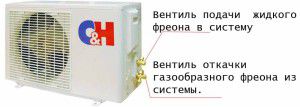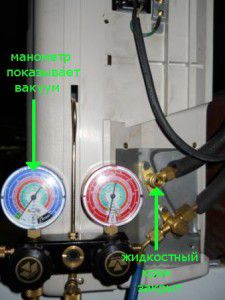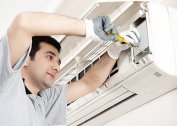Knowledge on how to remove the air conditioner from the wall with your own hands may be needed in several cases:
- if you plan to move;
- if necessary to carry out repair work;
- if it is planned to replace the air conditioner with a new one and there is no desire to pay for dismantling the old one.
To begin with, when changing the location, you should deal with disconnecting the air conditioner from the wall completely, that is, both blocks. In this case, it is important not only to perform high-quality dismantling, but also to observe the rules for transporting split-system modules.
How to remove the outdoor unit from the wall
First of all, they provide the necessary tools. To remove the air conditioner yourself, you will need:
- adjustable wrench or gas wrench;
- hexagons;
- spanners and socket wrenches;
- indicator screwdriver;
- pipe cutter;
- pressure gauge or gauge station.
Instead of a pipe cutter, you cannot use wire cutters and similar tools, since they damage the quality of the copper pipe.
First, the external module is removed - the condensing unit or KKB.
Step 1. The plugs of the valves are opened with an adjustable or wrench on the end face of the KKB.
Step 2 Close the liquid tap of the outdoor unit. Use an allen key.
Step 3 In order for all the freon to go into the external module, they start the air conditioner in cooling mode for 30-40 seconds. As soon as the compressor began to work only on suction, a pressure gauge station is connected to the valve from the gas pipeline and wait for the indicators to reset to zero. Immediately close the valve for the return intake of freon.
Step 4 The system is completely de-energized. Before proceeding to the next step of removing the air conditioner from the wall, the indicator screwdriver checks for lack of current by inserting it into the terminal with the phase.
Step 5 Now the freon line is cut with a pipe cutter, since it is an integral part of the structure. The remaining ends must be insulated from moisture and debris. For this, you can use electrical tape.
Connecting tubes are cut at a distance of 15-20 cm from the fittings. If the removal of the capacitor module is carried out in order to carry out repair and restoration work, then it is not necessary to cut the copper tubes.
Step 6. Carefully disconnect the drain pipe and the wires of the interconnects. The ends of the electrical wires and the drain pipe are also desirable to wrap with protective material.
Step 7. Now they begin to dismantle the device itself. How to remove the air conditioner external unit from the brackets? To disconnect it from nuts and bolts, use an open-end wrench or socket wrench. Since KKB usually has considerable weight, it is advisable to take a second person as assistants.
Step 8. The brackets are removed from the surface of the building or balcony by unscrewing the stop valves with the end head.
After the air conditioner has already been removed from the wall, they begin to pack it. To do this, you need a multilayer cardboard box, polystyrene and a soft packaging film in a roll.
KKB can only be transported in an upright position to avoid water hammer during subsequent operation. Before mounting the unit in a new place, let it stand for 2-3 hours.
If transportation is planned for the winter, you need to dismantle the air conditioner from the wall so that all the freon does not leak. For this, a gauge station is required.But most experts advise to lower the refrigerant and then completely refill the circuit.
How to remove an air conditioning compressor
The most serious malfunction of a split system may be a compressor breakdown. It occurs when:
- poor-quality installation - lack of vacuum, violation of the rules for laying a freon pipeline;
- using a split system in an unacceptable temperature range;
- factory marriage.
In this case, you also have to independently remove the KKB of the air conditioner and disassemble it. Some climate technicians do without complete dismantling, but it is problematic for a layman to do this, since in this option access to many elements is severely limited.
The outdoor module has been dismantled, how now to remove the air conditioning compressor? In fact, there is nothing supernatural here:
- The protective cover is removed from the body of the external unit;
- Disconnect the mains for discharge and suction, as well as electrical wires suitable for the fan and compressor;
- Unscrew the fastening with an open-end wrench or socket wrench and remove the compressor from the vibration dampers.
It should be noted that before removing the air conditioning compressor, it is necessary to check the degree of oil corruption. If it has an unpleasant odor and changes color when tested for oxidation, then replacement + flushing of CCB will be required. With normal properties and a negative reaction of the oil oxidation test, a simple replacement will suffice.
How to remove the indoor unit from the mounting plate
With how to remove the air conditioning compressor and the outdoor unit with your own hands from the wall, everything is clear. It remains to figure out how to dismantle the internal module. This process also takes place in several stages:
- Remove the protective cover from the housing;
- Unscrew the fasteners;
- All connecting communications are disconnected: freon highway, electrical interconnect cables, drainage pipeline. Pre-shut off the power;
- The block is removed from the plate by opening the latch fasteners;
- Unscrew the mounting plate and dismantle the plastic wire with the remaining copper tubes.
When removing the air conditioner indoor unit from the wall, extreme care must be taken not to damage the mounting latches holding the module on the mounting plate.
Be sure to mint the ends of the copper freon tubes in the same way as with the outdoor unit.
The room module is packed in a dense cardboard box, covered with foam and wrapped with a soft bubble wrap. Evaporative block can be transported in any position, unlike KKB.
If replacement or cleaning of any element of the indoor unit of the air conditioner is required, then it may also be required to remove it from the wall or partially disassemble it into components. It looks like this:
- Remove the front panel and wash its back with a stream of water with a cleaning agent or soap;
- Remove the airflow guide plates by pulling them neatly out of the grooves. Some models have special latches for this;
- Unscrew the screws, gently pull the lower protective part towards themselves and slightly raise its top, then remove it from the latches;
- Turn off the power wire and drain;
- Interconnect wires are disconnected from the corresponding terminals, after having recorded their location;
- Remove the hose tray. In some models, it can be stationary, then it is slightly lowered;
- Now the tangential fan is removed by lifting the evaporative heat exchanger up.
All elements are washed with water and a cleaning agent. You can use a steam generator for more thorough cleaning. When the parts are dry, they are secured in the reverse order to the places.
If you want to dismantle the control board, first remove the protective cover from the electronic unit, disconnect all the wires (connectors of the sensors on the display panel, air damper drive). After they unscrew the board from the fasteners using a screwdriver or simply disconnect it from the latches.
When the indoor unit is not dismantled but disassembled, there is no need to cut off the freon line.
Monoblock systems are dismantled almost as well. The only difference is a slightly different electrical circuit diagram and nozzles with a working fluid.
When self dismantling is undesirable
Do not remove the air conditioner with your own hands in the following cases:
- in the presence of a split system of column, channel or cassette type;
- if the user does not have the necessary tools, materials and instructions for the device;
- with the uncertainty of a person in his own abilities.
In these situations, it is better to contact professional installers.
Before starting independent actions, you can watch a video on how to remove the air conditioner yourself:








